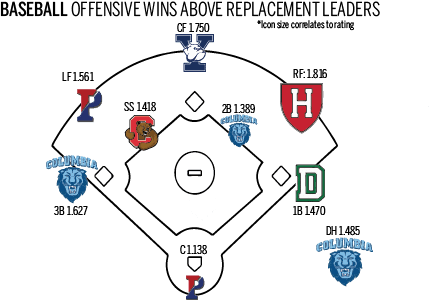
Since the turn of the 21st century, baseball has been getting smarter. At the Major League level, baseball statistics, or sabermetrics, influence nearly every decision teams make.
Perhaps the most important, or at least the most widely known, advanced baseball statistic is wins above replacement. Essentially, a player’s WAR measures how many more wins a team earns with that player rather than wins with an average replacement-level player. Replacement level refers to the skill of a bench player who might come in for a starter. Typically, the replacement level is below the league-average player, and, in terms of the Ivy League, one can think of Division III as the replacement level. With many Ancient Eight minds — including Cubs President of Baseball Operations Theo Epstein ’95 — making baseball smarter, it only seems right to apply these same advanced baseball analyses to the Ivy League.
I first begin by examining offensive WAR, commonly referred to as oWAR. The two main components used to calculate oWAR are batting runs and base-running runs. The number of runs for which a player is responsible while batting is computed by applying various weights to traditional statistics, including hits, walks, homeruns and runs batted in. The logic behind these weights is intuitive: A double is more valuable than a single, for example, but perhaps not twice as valuable.
Next, players are penalized for every double play they ground into, as they cost their team an additional at-bat by creating an extra out. To account for the value a player adds on the basepaths, I credit players for stolen bases and penalize them each time they are caught stealing. To translate runs created above replacement into oWAR, I divide by the runs per win, a constant. In the Ivy League, roughly 13 runs translates to one win; for comparison, this constant is 10 for Major League Baseball.
Three outfielders lead Ivy League baseball in oWAR: Dartmouth’s Trevor Johnson, Yale’s Tim DeGraw ’19 and Harvard’s Patrick Robinson. Despite not having hit a single homer this year, DeGraw has the second best oWAR in the Ancient Eight due to his elite base-running ability. Second baseman Simon Whiteman ’19 and captain and third baseman Richard Slenker ’17, who follow DeGraw at second and third in the lineup, rank 20th and seventh, respectively, in oWAR.
Interestingly, first baseman Griffin Dey ’19 only has the 34th-best oWAR in the conference, due to his below-average on-base percentage and lack of speed on the bases. Overall, Yale’s impressive sophomore class, headlined by DeGraw, Whiteman, Dey and designated hitter Benny Wanger ’19, has combined for an impressive 4.86 oWAR, the second best of any class in the Ivy League, behind only Harvard’s class of 2019.
In Ivy League softball, Columbia’s Sommer Grzybek and Madison Gott and Penn’s Leah Allen lead the way in oWAR; left fielder Shelby Kennedy ’19, the Bulldogs’ leadoff hitter, paces the Elis in fifth place. The beauty of WAR is that it allows us to see how important a player Kennedy is to the Bulldogs, something that traditional statistics do not make obvious. Despite having no homeruns, an average number of RBIs and just six extra-base hits on the season, the sophomore’s stellar on-base percentage and base-stealing ability makes her Yale’s most valuable offensive player by our metric.
In addition to examining oWAR, I explored a similar metric for pitchers, called pWAR. The primary statistic used to calculate pWAR is called fielding-independent pitching. FIP is a measure of how good a pitcher is based on statistics that only they can control: homeruns allowed, walks allowed and strikeouts. Minor adjustments are made based on pitchers’ earned-run average relative to league average, on whether a pitcher is a starter or a reliever and on the home park in which a pitcher plays most of their games.
Penn southpaw Adam Bleday leads all Ivy League baseball hurlers with a pWAR of 2.67. With the best FIP of any starting pitcher in the Ancient Eight, Bleday has clearly been much better than his 2–3 record might indicate. Scott Politz ’19, the ace of the Bulldog staff, currently sits fourth in the conference with 2.18 pWAR despite a sparkling 8–1 record, the best in the Ivy League. This case study perfectly illustrates why wins are not a good measure of pitcher value and that a player’s importance to his or her team may not show up in the traditional box score.
Among softball pitchers, Yale possess two of the league’s top eight pWAR-valued hurlers in Terra Jerpbak ’19 and Francesca Casalino ’18.
Perhaps the most impressive season, however, of any player — baseball or softball — belongs to Penn senior pitcher Alexis Sargent. Sargent’s pWAR of 4.77 is nearly one entire win higher than second place, and is four time greater than the pWARs of half the pitchers in the Ivy League. Simply put, Sargent is over four times more valuable to her team than roughly 80 percent of Ancient Eight baseball or softball players are to their respective teams.
Defensive WAR could not be calculated due to a lack of sufficient data. A complete list of Ivy League WAR and other advanced metrics can be found online.







